

© Shipping Wonders of the World 2012-

Drake and the “Golden Hind”
Although Sir Francis Drake was the second man -
SUPREME FEATS OF NAVIGATION -
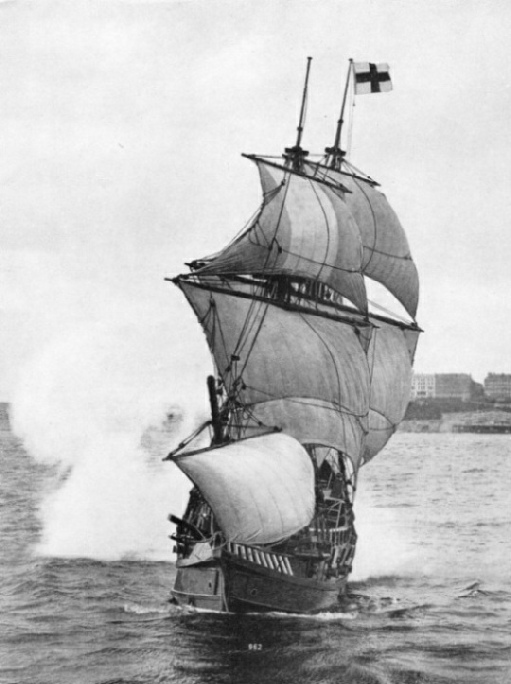 SIR FRANCIS DRAKE, the greatest of the Elizabethan mariners, is one of the fathers of British shipping and sea power. He asserted the right of English ships to sail in all the oceans; he defied the claim of the Spanish and the Portuguese to the greater part of the world; and he freed the seas from their domination.
SIR FRANCIS DRAKE, the greatest of the Elizabethan mariners, is one of the fathers of British shipping and sea power. He asserted the right of English ships to sail in all the oceans; he defied the claim of the Spanish and the Portuguese to the greater part of the world; and he freed the seas from their domination.
DRAKE’S FLAGSHIP on his voyage round the world is represented by a fine model of the Golden Hind specially built for Navy Week displays at Plymouth. This model, built as closely as possible on the lines of Drake’s ship, sails well with a small crew. The original Golden Hind was preserved as a memorial at Deptford, on the Thames, for about a hundred years after Drake had returned from his historic voyage.
Drake was a pioneer naval strategist who acted on the principle that the enemy should be fought in enemy waters. Moreover, he was a practical seaman. He had been apprenticed to the sea, and he had a thorough knowledge of rigging and the method of navigation of those days. This enabled him to gain victories over vastly superior forces because the enemy ships were commanded by soldiers and not by sailors.
The circumnavigation of the globe would be enough to place Drake among the greatest of the navigators; but Drake’s fame does not rest solely on this one voyage, important as it was. It was the second voyage of circumnavigation in the story of the sea. Magellan’s expedition, completed by the Victoria in 1522, was the first. As described in the chapter “The First Voyage Around the World”, Magellan was killed during the voyage. Drake, however, returned in 1580, alive and with a fortune in the hold of the Golden Hind. Thus he was the first admiral to sail round the world and return alive, and he gave the nation proof that English ships and mariners could go anywhere.
At that time the ships of Spain and Portugal controlled the world’s sea routes. Drake proved the superiority of the smaller English ships with better seamen and better gunnery. The exact dimensions of his ship are not known. Originally known as the Pelican, she was renamed the Golden Hind. After her world voyage she was preserved for about a hundred years, at Deptford, on the Thames.
Although she was riddled with shipworms when she returned, the Elizabethans preserved her, as she was to them what the Victory is to us now. The Golden Hind was a vessel of about 100 tons, probably 60 feet from stem to stern-
She was armed with eighteen guns, comprising six cast iron 4½-
The Revenge, Drake’s flagship in the actions against the Spanish Armada, was one of Queen Elizabeth’s ships, and was much more formidable. She was 92 feet in length, with a beam of 32 feet, a complement of 250 and a tonnage of 440. She came to a glorious end when, commanded by Sir Richard Grenville, she fought fifty-
The Revenge was not the largest English ship in the fight against the Armada, for the Triumph, Frobisher’s flagship, was of 1,100 tons and carried 500 men and an armament of forty-
The probable year of Drake’s birth was 1541. He was born near Tavistock, Devon, and was the eldest of the twelve children of Edmund Drake, a vigorous Protestant. Because of the struggle between Catholics and Protestants Edmund Drake left Devonshire and went to the Medway, where he was appointed Reader of Prayers to the Navy and was given an old hulk in which to live.
In this floating home Drake spent part of his boyhood before his father secured a parish ashore. The father was poor, and Drake was apprenticed to the master of a vessel which traded to France and Zeeland, so that he ceased to depend upon his parents. In the Thames Estuary, the North Sea and the shoal-
After a while the young, ambitious captain sold his vessel and returned to his native Devon to join in the sea ventures of his kinsmen, John and William Hawkins. He made his first voyage across the Atlantic in a ship commanded by a Captain Lovell, who was probably associated with the Hawkins family. At a town on the Spanish Main, Rio de la Hacha, there was some trouble with the Spaniards which caused loss to Drake and Lovell. When he returned to England, Drake joined John Hawkins, who was fitting out ships at Plymouth for a voyage to the Caribbean.
Hawkins was then the most famous English merchant-
The settlers needed the slaves to replace the natives whom they had exterminated, and Hawkins’s relations with the settlers were friendly. King Philip of Spain, however was furious. All the Englishmen except those who did not want to incur the anger of the Spanish king applauded Hawkins; many hastened, as Drake did, to join the next slave-
Six vessels sailed from Plymouth, two of them, the Jesus of Lubeck, 700 tons, and the Minion, 250 tons, being naval ships. They were old ships that had been repaired at the expense of the shareholders in the expedition. The Jesus of Lubeck had been bought from Lubeck by Henry VIII as one of the “great ships” of his navy, and she and the Minion were obsolete when Elizabeth lent them to the expedition. The other four ships were the William and John, 150 tons, the Swallow, 100 tons, the Judith, 50 tons, and the Angel, 32 tons. Drake was only about twenty-
Almost at the start of the expedition a gale badly damaged the Jesus of Lubeck. In Africa Hawkins embarked slaves; he then sailed to the Spanish Main and sold the slaves to settlers. He did not finish his transactions in time and was caught by a hurricane, suffering damage that entailed repairs in a harbour. So he put into the Mexican port of San Juan d’Ulua. Unluckily for him and for Drake, the ships were scarcely anchored before a Spanish fleet of thirteen ships, which had been warned to look for the English, appeared offshore. Hawkins seized the fort and refused to allow the Spanish fleet into harbour until the Spaniards signed an agreement not to attack him. The Spaniards agreed to this, but a few days later treacherously attacked the English.
Drake, who was ashore, escaped by grabbing the bowsprit of the Judith, swinging himself on board and then working her out of the harbour. Hawkins gained the sea in the Minion and a third vessel got outside in such a condition that she had to be abandoned. The Jesus of Lubeck, with the money in her, was taken by the Spanish; other ships were sunk and many men were captured. The Judith and the Minion lost one another. Drake sailed into Plymouth with the news of the disaster and Hawkins arrived later in the Minion after a terrible voyage.
Raid on Treasure Caravan
This treacherous attack infuriated Drake. He vowed a private war against the Spaniards, and from then until his death he attacked them unrelentingly. The Spaniards regarded him and all the English as pirates. Drake followed the practice which allowed an English subject to recoup himself for losses due to nationals of a country not officially at war with England. He was distinguished for his chivalry to captives and not one act of cruelty can be laid against his name, whereas the Spaniards tortured or killed their English captives. The seafaring Spaniards admired his exploits as much as they resented the blunderings of their own incompetent soldiers afloat.
Ruined by the treachery of the Spanish, Drake went to sea in royal ships for a time. Then he made a scouting voyage to the Caribbean with two ships, the Dragon and the Swan. He made a second voyage in the Swan, which was of only 25 tons and was handy for exploring coasts of which the Spanish held the secrets. On the coast of Darien (Panama), Drake established a base, which he called Port Pheasant. He discovered that the Spaniards shipped gold and silver from the Peruvian mines to Panama, and sent the treasure by mule train overland to Nombre de Dios, near the mouth of the Chagres River, on the Atlantic side of the isthmus.
This was a much easier way than sending ships through the Strait of Magellan and up the west coast of South America to ship the gold and take it to Spain. After having captured a few Spanish vessels, Drake buried stores at Port Pheasant and returned to Plymouth to secure reinforcements. He came back to Port Pheasant in a 70-
Drake arrived at Port Pheasant and saw a message written on a leaden plate fixed to a tree by a Plymouth man, warning him that some of the Spaniards he had freed had dug up his stores and taken them away. Drake built a stockade for defence, and then set up three pinnaces he had brought from England in sections. His shore adventures were numerous, and after several failures he made a successful raid on the treasure caravan.
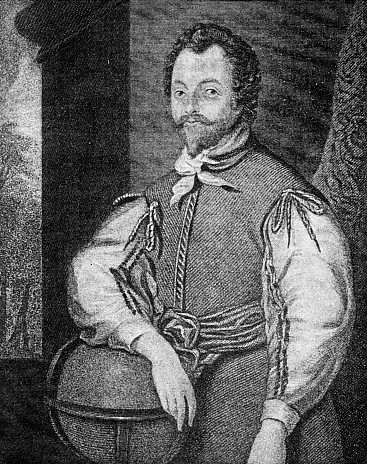
SIR FRANCIS DRAKE was born near Tavistock, Devon, in 1541. Part of his boyhood was spent on the River Medway in Kent, where his father was Reader of Prayers to the Navy. After an apprenticeship in a trading vessel, Drake was given command and ownership of her. There followed voyages across the Atlantic, in which he experienced treachery at the hands of the Spaniards. His exploits in Central America brought him his first glimpse of the Pacific from a peak in Darien. The circumnavigation of the world was followed by exploits against Spain, the famous “ singeing of the King o* Spain’s beard ” and the Armada. He sailed to the Caribbean on a voyage that proved to be his last. On January 23, 1596, Drake died ; he was buried at sea near Nombre de Dios, the scene of his youthful adventures.
Drake joined forces with the Maroons, children of escaped negro slaves, who took him to a tree on the hills of the isthmus of Panama. There he prayed that one day he might sail an English ship in the sea he saw before him — the mighty Pacific Ocean. His lieutenant was the first Englishman to sail a vessel in the Pacific. This man, John Oxenham, later repeated Drake’s exploit of crossing the isthmus, and built two boats. He was afterwards captured and put to death by the Spaniards.
Neither the Swan nor the Pasha returned to Plymouth. Drake caused the Swan to be scuttled secretly by the carpenter, Thomas Moone, so as not to hurt the feelings of John Drake, who had agreed to the destruction of his ship. John Drake and Joseph, another brother, both died during the expedition. Francis Drake afterwards broke up the Pasha and sailed home in a frigate he had captured.
From the time of Drake’s return to the beginning of his voyage round the world he developed into a courtier, able to keep his head in the complicated intrigues of the day. He returned a man of fame and fortune. The adaptability which had enabled him to get the most out of his rough seamen made it possible for him to mix on equal terms with the foremost soldiers and statesmen and to win the ear of Elizabeth. At one time Drake commanded a vessel in the fleet Elizabeth sent to Ireland, and during this period Drake became friendly with Thomas Doughty, courtier, scholar and soldier.
Drake was imbued with the ambition to reach the Pacific and attack Spain in waters where she never expected to find hostile ships. To do so he would have to pass through the Strait of Magellan, and no ship was known to have done that since the pioneer Magellan had struggled through. Drake knew that he could equal or even surpass the feats of Magellan.
Some of the Queen’s advisers, notably Lord Treasurer Burleigh, regarded Drake as a dangerous adventurer likely to precipitate war with Spain, as they were not convinced that the Spaniards intended to make war upon England.
General of a Squadron
Elizabeth, wishing to keep the secret from Burleigh, promised Drake a thousand crowns and her secret support. The Queen became a shareholder in the expedition, which was going ostensibly to Alexandria, in Egypt. Doughty, who was jealous of Drake, told Burleigh as much as he knew, and then, with his brother, joined the venture as a gentleman volunteer.
For the first time in his career Drake was in command of a squadron of five vessels as general, a term also used for admiral. His flagship was the Pelican, later renamed the Golden Hind. The vessel next to her in size was the Elizabeth, 80 tons, armed with sixteen guns and commanded by John Winter. Then came the Marigold, 30 tons, and a victualling ship of 50 tons named the Swan after Drake’s previous ship, commanded by John Thomas. Thomas Moone, Drake’s former carpenter, commanded the Benedict, a pinnace of only 15 tons.
There were 164 souls in the squadron, including a chaplain, Francis Fletcher. Drake’s flagship was furnished for effect as well as for efficiency. His tableware was silver, there were fiddlers to provide music when he dined, and he had a page — his nephew John Drake — to stand behind his chair. The oak furniture of his cabin is preserved in Berkeley Castle, Gloucestershire, and Drake’s drum is at Buckland Abbey, Devon, the house he bought from Sir Richard Grenville in 1581. There was policy in this elaborate furnishing; he wanted visitors and prisoners of distinction to admire the display and magnificence of the English.
Late in 1577 the ships sailed from Plymouth. A storm damaged them and compelled them to put back for repairs, and they did not finally leave England until the middle of December. When the land was below the horizon Drake told his crews that they were bound for the Pacific and not for the Levant. They captured several small vessels off the African coast, discarding the tiny Benedict for a 40-
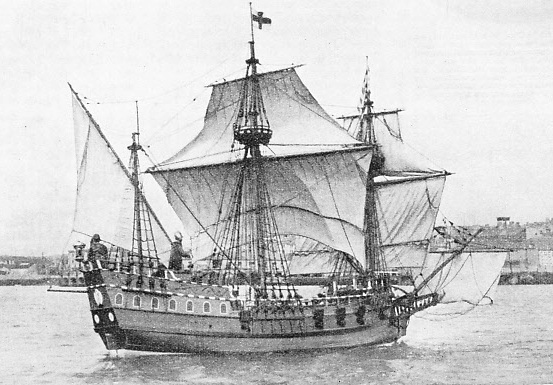
A FINE MODEL of the Golden Hind in Plymouth Harbour in 1936. Originally known as the Pelican, Drake’s famous ship had three masts and a long beak bow. Accurate dimensions are not known, but she was a vessel of about 100 tons, with a length of about 60 feet and a beam of 19 feet Her normal draught was about 9 feet, or 13 feet when fully laden. She carried eighteen guns and had a complement of over eighty.
Then arose a point of discipline which was of great moment. Doughty and his fellow gentlemen adventurers were soldiers, and knew little of seamanship. The master or captain of the ship was responsible for the navigation and the crew, and Doughty represented that Drake had delegated his authority to himself. The trouble was increased when Doughty and the others played a rough joke on the trumpeter whom Drake had sent to the Pelican with a message. Drake resented this interference with his messenger, and sent Doughty to the Swan; made the master of that vessel responsible for him, and resumed command of the Pelican.
During the long voyage across the Atlantic and southward down the coast towards the Strait of Magellan, the ships frequently lost sight of one another. They were delayed by foul winds and bad weather, and the crews were restless. Doughty was moved from one vessel to another, followed by a trail of discontent. After they had put in at various havens the vessels reached Port St. Julian, north of the entrance to the Strait. This was where Magellan had put down a mutiny nearly sixty years before; indeed, they found the stump of the gibbet he had erected. Here Doughty was charged with mutiny and treason before a jury.
Doughty believed that Drake’s commission from Elizabeth giving him power of life and death would not be applied to himself, a gentleman adventurer and not a seaman. To convince the court of his standing with the powerful Burleigh he revealed that he had been to Burleigh and told him the plans of the voyage. This was a surprise for Drake. He called the others aside and told
them the whole story. The court found Doughty guilty and condemned him to death. Doughty met his death bravely.
His execution did not end the trouble between the gentlemen and the sailors. The gentlemen regarded Doughty as a martyr and the affair preyed on Drake’s mind for the rest of his life. He called the entire company together and told them that the bickering must stop. “I must have the gentleman to haul and draw with the mariner and the mariner with the gentleman”, he said. “I would know him that would refuse to set his hand to a rope”.
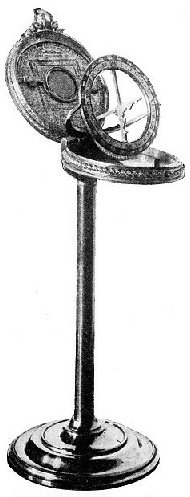 He offered the Marigold to any who wished to return to England, adding the warning, “But let them take heed that they go homeward. For if I find them in my way I will surely sink them”. Nobody wanted to return. Drake then disrated all the ships’ officers, made an appeal to their patriotism, reinstated all the officers and prepared to resume the voyage.
He offered the Marigold to any who wished to return to England, adding the warning, “But let them take heed that they go homeward. For if I find them in my way I will surely sink them”. Nobody wanted to return. Drake then disrated all the ships’ officers, made an appeal to their patriotism, reinstated all the officers and prepared to resume the voyage.
Drake’s handling of the knotty problem of whether sailor or soldier should command at sea established a precedent in England and led to the realization that the Navy was the premier arm. Drake sailed to the entrance of the strait, where he reduced the number of his ships to three. Here he renamed the Pelican the Golden Hind, after the crest of Sir Christopher Hatton, Captain of the Queen’s Guard, who was high in her favour and had helped to secure her interest in the venture. The two other ships were the Elizabeth and the Marigold.
DRAKE’S ASTROLABE was not only an indispensable navigational instrument, but also a remarkably beautiful piece of workmanship. The astrolabe was used to take altitudes and to mark the positions of the sun, moon and stars. In the eighteenth century the astrolabe was superseded by the quadrant and later by the sextant.
The three ships won through the strait to the Pacific, where a long ordeal awaited them. Storms drove them south into unknown waters, and one night a cry was heard. When morning dawned the Marigold was missing; she had been overwhelmed and sunk. The two surviving ships won back to the mouth of the strait and anchored to await a fair wind. Then a gale parted the cable of the Golden Hind and she had to beat off-
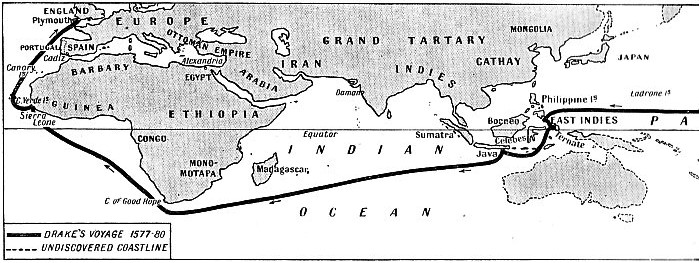
DRAKE’S VOYAGE ROUND THE WORLD is shown on the map above, reading from right to left. He started from Plymouth in December 1577, when the ships Pelican (later the Golden Hind), Elizabeth, Marigold, Swan and Benedict sailed ostensibly for Alexandria, Egypt. Once out of sight of land, Drake told his crews the true object of their voyage. Trouble was caused by Doughty, a gentleman adventurer, who after a full trial was executed at Port St. Julian, Patagonia. Only three ships, the Golden Hind, the Marigold and the Elizabeth hazarded the Strait of Magellan. A storm arose and the Marigold was lost with all hands. The Golden Hind was driven south and continued the voyage alone, for the captain of the Elizabeth thought Drake was lost and returned home in his ship. Drake captured much treasure and many Spanish ships in the Pacific. In an attempt to find the North-
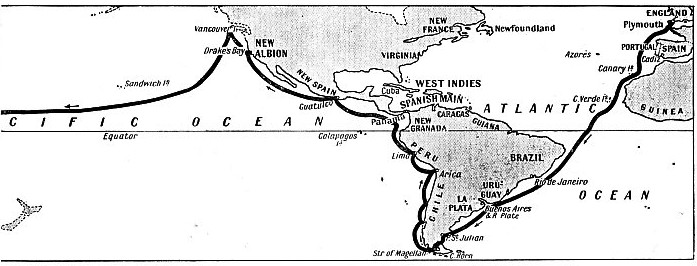
The ordeal of the Golden Hind continued. At one place near the shore a boat Drake sent out with eight men and one day’s provisions was caught by a storm and failed to regain the ship. The men passed through the Strait of Magellan and went up the east coat to the mouth of the River Plate, where seven of them were killed by the Indians. The eighth man, John Carter, escaped, and, helped by the Portuguese, he reached England nine years later.
Storms battered the Golden Hind and drove her south farther than any ship had been before, and Drake discovered the uttermost cape, later to be named Cape Horn by the first Dutchmen who sailed round it. He proved that the Atlantic and the Pacific met and that the Strait of Magellan was not a channel through land that stretched down to the South Pole, as had been thought.
Drake was the first seaman to sight the cape which was to be the most famous corner of the World and a terror to all sailors until the cutting of the Panama Canal made an alternative route. He landed on one island, went to the edge of a cliff and told his men that he had been farther south than any other explorer. He named the islands the Elizabethides. “Our troubles did make an end, the storms ceased, and all our calamities (only the absence of our friends excepted) were removed,” writes Chaplain Pletcher. Drake found two islands where the voyagers obtained birds and revictualled, they steered north-
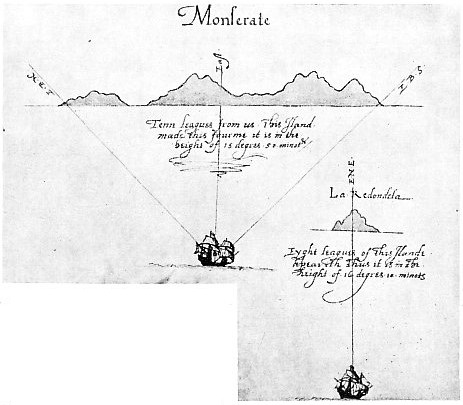
A DRAWING FROM AN OLD ATLAS illustrating Drake's last voyage to the Caribbean in 1595-
This incident was the last serious mishap. After having wasted some time searching for the Elizabeth, Drake sailed up the coast. In command of one vessel unencumbered by consorts Drake was at his best. Sailing so close to the shore that any person travelling on land could be seen from the ship, Drake began a series of raids on towns and the capture of ship after ship.
At first the Golden Hind was mistaken for a Spanish ship and made easy captures, but later the news spread along the coast and Drake abandoned his prizes after he had transferred their contents to the Golden Hind. Then he sailed in search of the greatest prize, the treasure ship Cacafuego, which was carrying treasure to Panama from Peru. The ship was captured and Drake sailed out into the Pacific to be sure of no interruption when the treasure was transferred from the Cacafuego to the Golden Hind.
He treated the Spanish captain, Juan de Anton, with courtesy, telling him that he was recouping himself for the losses that he and Hawkins had sustained. Thinking that Winter, captain of the Elizabeth, might be in the Pacific, Drake gave de Anton a letter of safe conduct lest Winter should attack him. The letter asked Winter to pay de Anton double the value of anything he needed from his ship and to use him well. Then he released the Spaniard and allowed him to sail to Panama.
From the evidence of de Anton, of Francisco Zarate and of other Spanish prisoner-
The ship was exceptionally well found and carpenters and caulkers were carried for repairs. There were also men who sketched the coast so accurately that anyone who followed Drake could be sure of the course. On Sundays Drake would put on his best clothes and the ship would be decked with flags and streamers.
Among the officers was a Portuguese pilot whom Drake had taken from a ship captured off Africa because the pilot knew the Brazilian coast. This man, Nuno da Silva, was put on board a ship bound for Panama when Drake put into Guatulco, Mexico, the last port which he raided.
The North-
After wards da Silva wrote narratives and depositions which shed light on the incidents of the voyage. Whenever Drake captured a ship he took her charts and her pilot, as was the practice of those days when the Spaniards and Portuguese kept their knowledge of the New World to themselves.
After he had left Guatulco Drake considered his route home. He did not risk returning by the way he had come because he guessed that Spanish squadrons would be searching for him, so he sailed west by north for weeks, hoping to find the North-
The Red Indians at first worshipped the visitors as gods and then invited Drake to be their king, and he took possession in the name of Elizabeth of what is now part of California. He called the country New Albion; but the annexation was not confirmed by settlement. When Drake sailed, the Red Indians lit beacons on the hills and crowded round as the Golden Hind began her long passage across the Pacific.
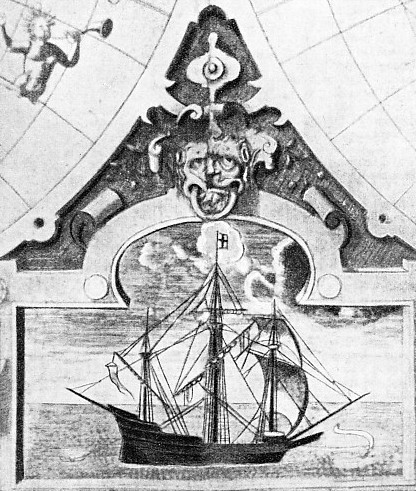 In the East Indies the Sultan of Ternate sent canoes which towed the ship to a safe anchorage, while the Golden Hind towed the Sultan’s canoe and Drake’s musicians entertained him with music. The Sultan was friendly and offered Drake a treaty giving the English the right to trade in spices. Drake again refitted the ship and rested the crew and then sailed. He tried to go northward of the large island of Celebes, but was driven south by the wind into a maze of islands and reefs.
In the East Indies the Sultan of Ternate sent canoes which towed the ship to a safe anchorage, while the Golden Hind towed the Sultan’s canoe and Drake’s musicians entertained him with music. The Sultan was friendly and offered Drake a treaty giving the English the right to trade in spices. Drake again refitted the ship and rested the crew and then sailed. He tried to go northward of the large island of Celebes, but was driven south by the wind into a maze of islands and reefs.
A MEDALLION from a Map of Drake’s Voyages published in 1595 is quoted by Hakluyt as being interesting because it “ is probably the only representation of the famous ship (the Golden Hind) now in existence.”
The ship was sailed under reduced canvas until all dangers were apparently passed. Soon after full sail had been set she ran on to a reef and stuck fast. The men threw three tons of spices, eight guns and some stores overboard in vain. The ship was lodged on a shelf on the edge of water too deep to anchor and was kept there by the wind for twenty hours. Then the wind shifted, canvas was set and she moved into deep water. Drake then sailed to Java, where he was entertained by various rajahs and was told of the presence of ships as big as the Golden Hind. Not wishing to risk an action, Drake sailed on a long passage round the Cape of Good Hope. He did not anchor once until he reached Sierra Leone, where he stopped for water. Then he pushed on for Plymouth and arrived there on November 3, 1580.
Captain Winter had long before returned in the Elizabeth with the news that Drake had vanished. The Golden Hind was a lost ship that had returned with a vast fortune in her hold. The amount of the treasure is a secret known only to Elizabeth and Drake as, before the official inventory was taken, Elizabeth told him to reimburse himself and reward his crew. Drake gave Elizabeth his private log of the voyage, and afterwards it disappeared. The queen knighted Drake at a banquet on board the Golden Hind at Deptford, and he was acknowledged as the greatest of her sea-
Drake’s next voyage, in 1585, was in command of a fleet which included two Navy ships. The largest of these was the Elizabeth Bonaventure, of 600 tons. The remaining nineteen ships were privately owned. This force, far larger than any Drake had previously commanded, inflicted great damage in the Caribbean and returned home in 1586.
News of the huge ships which Philip of Spain was building to attack England prompted Elizabeth to lend Drake four ships for his expedition to Spain in the following year, although the two countries were officially at peace. Drake sailed again in the Elizabeth Bonaventure with three other naval ships, the Dreadnought, 400 tons, the Rainbow, 500 tons, and the Golden Lion, 550 tons. The fleet totalled twenty-
Rout of the Armada
The attack on Cadiz was a magnificent feat, and was described as “singeing the King of Spain’s beard”. Drake sailed into the harbour and burned thousands of tons of shipping, thereby delaying the fitting out of the Armada. He sailed up the coasts of Spain and Portugal, inflicting further damage.
Drake’s attacks in Spanish home waters delayed the sailing for that year, but in 1588 the Armada put to sea. Second in command to Lord Howard of Effingham, the Lord High Admiral, Drake played a leading part in the actions in the English Channel. In the Revenge he captured a huge galleon, which was sent into Torbay (Devon), where powder was taken from her and forwarded to the English fleet. Having rejoined the fleet, Drake fought the Spanish ships, which were shattered in the main action off Gravelines, near Dunkirk, France.
When the English ships had to draw off for lack of powder the wind drove the Spaniards towards the shoals. A change of wind enabled the remnant of the Armada to steer up the North Sea. Storms wrecked many ships on the coasts of Scotland and Ireland, and only 9,000 of the 30,000 Spaniards who had embarked returned to Spain.
The Armada marked the peak of Drake’s career. In the following year he sailed in the Revenge with a fleet of 180 vessels, the greatest fleet that had ever left England, for a combined naval and military attack to free Portugal from the Spaniards. Although the nucleus of a new Armada was destroyed, the main object was not attained.
Drake’s last voyage began in 1595. He sailed with John Hawkins to the scene of his youthful adventures in the Caribbean. The expedition was fatal to both. Hawkins died of fever, and Drake died of dysentery on January 28, 1596. He was buried at sea off Porto Bello, the new city that the Spaniards had built west of Nombre de Dios.
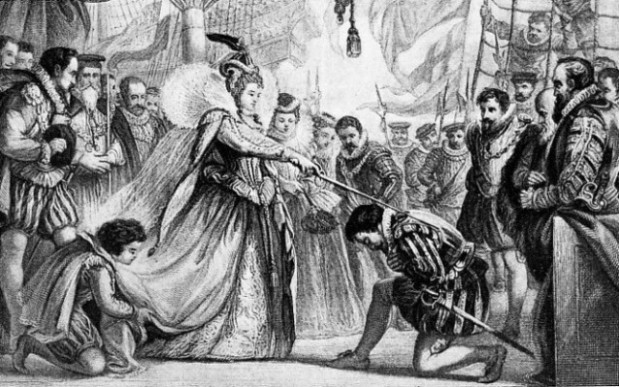
QUEEN ELIZABETH KNIGHTED DRAKE on board his ship the Golden Hind at Deptford, on the River Thames, on April 4, 1581. This illustration, after Gilbert, gives an impression of the splendour and importance of the scene. The first Englishman to sail round the world, Sir Francis Drake was acknowledged to be the greatest of Elizabeth's sea-
You can read more on “First Voyage Round the World”, “The Invincible Armada” and
“The Voyages of Vasco da Gama” on this website.